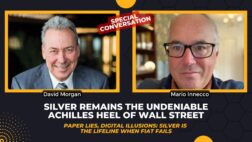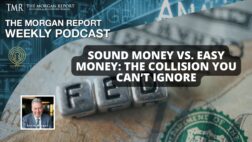Silver in the Next Decade
By David Morgan
What can be expected from the silver market over the next decade? The general thinking is that investment demand will drive silver prices far higher. As well, silver’s unique properties will be in higher and higher industrial demand over the next ten years.
In an effort to compensate for my bullish bias for silver I have been conservative in some areas of possible increased demand. The demand for silver in consumer electronics, for the purposes of this report, is presented as having little to no growth. More and more silver is being recovered from recycled circuit boards. This silver is being recovered even though it is sometimes not economic to do so. In California, for example, silver, lead, zinc, etc., must be recovered for environmental reasons and at a far greater cost than breakeven. This conservative approach takes into consideration that silver demand will probably increase in the electronics industry but so will the amount of recycled silver. For the purposes of this analysis, we will consider the demand growth to recycle rate to remain in balance over the next the 10 years.
Looking back, roughly between 2000 and 2010, we will find some interesting facts about the silver market. Industrial demand early in the decade was roughly 35% of the total market, but by 2010 industrial demand was 54% of the total market, according to the Silver Institute. The silver market was in a deficit situation from about 1990 which continued until 2007 or so, when, according to both the Silver Institute and the CPM Group, mine production brought silver’s annual demand and annual supply into balance. Up until then, the aboveground silver supply was disappearing at the rapid rate of roughly 100 million ounces per year. From 1990 to 2007, according to the best recognized studies covering the silver market, about 1.5 billion ounces of silver were taken from stockpiles. The Global Silver Production Chart indicates that a slump began around 1990. About the year 2000, silver production increased as the global demand for commodities in general and metal in particular took off. The increase in silver mining production was so great that currently the amount of silver mined annually is roughly equal to total annual demand. For the purposes of this article, we are going to assume that the silver supply is going to continue in the region of a 2%-per-year increase, for the next 10 years. Refer to the Global Silver Production Chart.
What about future production?
Some may be familiar with the terms peak gold or peak silver. According to the United States Geological Survey (USGS), there is more or less nine years’ worth of economic silver in the ground; in other words, peak silver is roughly a decade away. Dr. L. David Roper’s World Silver Extraction Analysis gives a pretty clear picture of the probable future of silver extraction. Refer to the World Silver Extraction Chart.
Notice the silver peak is beyond 2020, and this could be the case if we consider that perhaps silver is only economic for nine or 10 more years (at today’s prices).
Profitable base metal miners will continue to produce silver as a byproduct of lead, zinc, and copper mining but their contribution to global silver supply is difficult to predict. Gold mining, however, has most likely peaked already, and a full 13% of silver comes to the surface as a result of gold mining. For the purposes of this article, though silver supply from gold mining is decreasing, we are conservatively considering it will remain level.
Solar Energy
According to Stephen Leeb, a financial market analyst/commentator and author, it takes 80 tons of silver to produce one gigawatt (GW) of solar power. Most sources agree that about 7 gigawatts of solar-generated energy have been installed globally and solar energy demand is increasing exponentially.
China has been growing its solar energy base around 100% a year since 2003. The drive for solar energy will continue this decade, but it will account for a very small portion of total energy produced. India plans to increase its solar output to 20 gigawatts by 2020, starting from basically nothing. China continues to project massive growth from the current 5.5 GW capacity to 30 GW by 2020. The US has forecast a similar amount, perhaps 30 GW by 2020.
On a worldwide basis, the generating capacity by 2020 is projected to be 20 to 40 times the amount of current solar capacity. This is a huge compounded rate of use, but according to Jessica Cross, VM Group, her outlook presented at the end of last year to the London Bullion Management Association (LBMA) was for an annual growth rate of 15% over the next 10 years.
Even with this more conservative and perhaps more realistic approach, solar demand could reach 130 million ounces per year around 2014 and continue through 2020. There is not enough silver to provide solar energy for the earth’s six billion-plus people.
RFID Tags
One little-known silver application is its use in radio frequency identification devices (RFIDS), chips or tags that can be read digitally. As I stated in my book, Get the Skinny on Silver Investing, Common RFIDs can be scanned/received only up to 5 metres. Next generation RFIDs will have a silver antenna and can be scanned from a distance of up to 15 metres. Because silver can be thinned and rolled, a silver antenna that can be folded many times is longer, smaller and more efficient. Though there is a small amount of silver in these chips, the expected go ahead from the International Standardization Organization (ISO) for RFIDs in November should really give the metal a boost.
Our preliminary research into this area produced some rather startling results. The minimum use of silver for an RFID is 1/100 of a gram of silver. However, our sources indicate about 100 billion RFIDs will be produced on an annual basis. This would produce a consumption rate of over 30 million ounces of silver annually, and most of this silver would end up in the waste dumps as silver from RFIDs can’t be recycled.
My estimate of 30 million ounces per year is much greater than what was presented to the LBMA by Jessica Cross. Her number is just over 10 million ounces silver per year. This report uses her number. My higher number is based upon the fact that the lowest amount of silver is assumed in her analysis, which means the sensor or scanner is in very close proximity to the actual product. In fact, it may turn out that most RFIDs will use more silver so they can be read from greater distances. More silver is required to transmit electrical signals further. The RFID tag will be used to track more information in the future.
Medical Uses of Silver
Due to its antibacterial properties silver is being used more in medical applications. Bandages and wound cleansers contain silver as do catheters, pacemakers, valves, feeding tubes, and almost any medical device that touches the body. Hospitals also use silver in air ducts to protect against Legionnaires Disease. The estimate for silver’s medical is that it will increase by 100 million ounces by 2020.
Textiles
The thermal qualities and bio features of silver make it perfect for the commercial textile industry. Silver is used in high end athletic wear for its anti-microbial properties that inhibit bacteria growth that can cause odours. Traditionally, silver and gold thread, have been woven into garments. The sari in India is often uses silver and sometimes gold thread as an adornment. Slow to start, the forecast is the textile industry will use 30 million ounces by 2020, but this is a very gradual buildup during the 2010 to 2015 timeframe.
Food and Water
Silver will play a significant role in the food industry over the next decade. The FDA has approved the adding of silver to bottled water to help kill bacteria. This government approval opens the door for major municipalities to use silver for water purification at the local community, city, and state level.
Silver-tipped cutting instruments are used in meat processing. It is also used in the processing of milk, in cheese manufacturing, and in the baking industry. The forecast for silver use in the food industry and water purification applications is that it will reach 90 million ounces per year by 2020.
Other Silver Uses
There are other applications of silver. Silver is being used as a wood preservative. According to the Silver Institute, the amount of silver that potentially could be used to replace Chromate Copper Arsenate (CCA) per the mandate of the US Environmental Protection Agency could reach up to 50 million ounces per year (2005 reporting period). This estimate might be a bit high as the use of silver for these types of applications is down significantly, to about 1/5 the level reported five years ago. A more conservative estimate is that perhaps 10 million ounces of silver will be uses on an annual basis.
Another significant use of silver is as a superconductor primarily in large industrial and military motors. At one time silver was held as a strategic stockpile for military applications. It is difficult to estimate silver usage in this area as the information is often a tightly held secret. The likely valid assumption is that the number is buried within the general industrial applications already outlined above. There have been rumors that superconductivity can be achieved in wiring without the use of silver. To my thinking, this is doubtful, but it cannot be ruled out entirely.
A significant amount of silver is made into coins. Congress decided to use the silver in the Silver Eagle coinage program, which ate up the entire US silver supply a few years ago, and now silver must be purchased off the open market to keep the coin program continuing.
The future for silver looks bright indeed from an industrial application perspective. Many established industrial applications uses will continue to use silver and its use will increase in many new application areas will continue to grow at significant rates. In fact the computation is for the industrial side to have a compound silver use growth rate of about 14%.
Recycling – the Wild Card
The use of silver in photography does not have much of an impact on supply as the silver used in the photography process is recycled. The use of silver in this area has declined measurably, the last several years, as digital cameras replace film cameras. The recycling of silver from x-ray film continues but this will also decline as digital x-rays are increasingly used.
According to both the Silver Institute and CPM Group, the amount of silver recycling on an annual basis is around the 250 million ounces-per-year level. Jessica Cross states she reckons it to be closer to 400 million ounces. You can how difficult it is to get a clear idea of the numbers. For the purposes of this article we will use the numbers from the Silver Institute and CPM Group studies, and figure 250 million ounces on an annual basis and growing.
Much of the silver in high-growth applications can be recycled, such as silver from solar batteries and some consumer electronics, but silver used in RFID tags and most medical applications will not be recycled. It may be safe to assume a constant rate of turnover at some point, perhaps 2015, where the total amount of silver recycling is 300 to 350 million ounces per year. This number seems high, but it does include coin melt, silver jewellery recycling, photo waste, and electronic waste.
Investment Demand
It is my much studied opinion that the real story and the most misrepresented on the silver market is the true investment demand for silver. Coin demand as perhaps 7% of the total demand apart from investment demand for silver bars.
In our special report, Silver Fundamentals, Fundamentally Flawed, one can clearly determine that from the middle of 2006 when the ETF (namely, SLV) began, we started with about 130 million ounces of silver in commercial bar form. Take a look at the Transparent Silver Holdings chart. But notice since that timeframe other ETFs have begun, and existing bullion investment companies such as Central Fund of Canada have continued to increase their holdings of silver. If you study this carefully, you will be able to account for all the reported aboveground silver in commercial form. The amount of investment demand for silver is considerably more than reported by any of the official studies.
First let’s clarify the coin market report. Taken as about 7% of the market, we can determine that approximately 30-40 million ounces of silver is taken out of the market as official coins, such as the Silver Eagle, Silver Maple, Silver Philharmonic, and all no name (private mint) silver rounds (silver one-ounce medallions – serving as coins without a government mint marking).
This number is accurate, but the number that always seems to be missing is the investment demand for commercial silver bars – the type of silver used in industry but held for investment purposes.
Remember, these are approximations, and no one knows the precise amount, but both of the most respected studies on silver tell us that 600 to 700 million ounces of silver exist in thousand-ounce bar form. All of the silver shown in the Transparent Holdings Chart is for investment purposes, with the exception of the Comex. For the Comex, only about half of the holdings (~118 million ounces) are held for investment purposes. The other half, or 60 million ounces, is dealer inventory that is held against multiple short positions. What does this add up to? Though there is a float of 60 million ounces of commercial grade silver available, in the entire world, it has multiple claims against it!
Notice that we have increased from the middle of 2006 at about 250 million ounces, to 600 million ounces at the end of 2009. This is an internal compounded rate of 18%. And 475 to 600 million a year later, means perhaps 125 million ounces of silver were taken up as investment demand between the beginning of 2009 and the start of 2010. We can basically state that investment demand for silver in commercial form has been increasing at about 100 million ounces per year for the past three years. However, Transparent Holdings Chart shows that things have been leveling off the past few months. There is nothing certain in the investment world, but everyone at this point should be asking the question: “What happens if the investment demand for silver in 2010 is 100 million ounces of physical and there is a float of only 60 million ounces available?” Would anyone want to be short the silver market at this point? It would take roughly a billion dollars at today’s silver price to corner that last remaining 60 million ounces of silver.
I just want to touch on this point one more time before making some conclusions. We have made an assumption that silver production will increase every year over the next decade at about 2% compounded per year. We are projecting that we can add 13 million ounces per year, at a minimum. This is doubtful in reality, since most of the major silver producers – Pan American, Silver Wheaton, Silvercorp, and several of the juniors – are not yet at full production.
However, there are many more variables than just primary silver miners. We discussed the gold miners and briefly outlined the base metal miners. Suffice it to state, our 2% approximation is sufficient to make some sound projections.
The silver market is poised for significant pressure to the upside over the next decade. The amount of increase in investment demand is the primary driver. Additionally, the rate of increase of silver’s industrial use is much greater than the rate of increase of silver production. However, the total amount of silver produced by 2020 could be near the 800 million-ounce mark, an increase of 150-200 million ounces. The amount of increase in industrial demand will be conservatively 250 million ounces by 2020.
Recycling is a factor that cannot be overlooked and will most likely increase over the next decade. The question is whether the amount of recycled silver will fill the supply gap; it seems very unlikely to do so. It is difficult to forecast when the tipping point will come, when investment demand and industrial demand combine at some level to put great pressure on the silver price. To be fair, we must acknowledge the fact that the SLV does hold a great deal of physical silver and this could be mobilized to reduce the price by the market makers.
The bottom line is that the physical silver supply is very tight and the market is poised to move up on any substantial buying pressure.
Join The Morgan Report today!
If you are not ready to become a member you may want to join our free email list and receive the updates on conferences, video presentations, webinars, special offers, and tracking recent news and interviews. You will also receive information on companies we think have merit from time to time. All we ask is a first name and your email address, you can opt out at any time.
David Morgan publishes an online newsletter, The Morgan Report, for resource investors interested in silver, silver stocks and the news surrounding what is sometimes called the poor man’s gold. He is also the author of Get the Skinny on Silver Investing, a comprehensive book on silver. David also speaks at resource stock investment conferences throughout North America.



